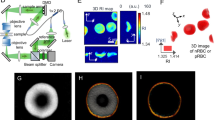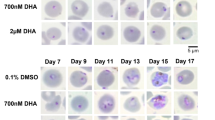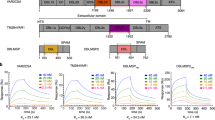Abstract
There is a need for improved methods for in situ localization of surface proteins on Plasmodium falciparum–infected erythrocytes to help understand how these antigens are trafficked to, and positioned within, the host cell membrane. This protocol for confocal immunofluorescence microscopy combines surface antigen labeling on live cells with subsequent fixation and permeabilization, which enables antibodies to penetrate the cell and label internal antigens. The key steps of the protocol are as follows: indirect labeling of the surface antigen using a fluorescently tagged secondary antibody; fixation and permeabilization; indirect labeling of the internal antigen using a secondary antibody tagged with a spectrally distinct fluorescent dye; and detection of the differentially labeled antigens using a laser scanning confocal microscope. The protocol can be completed in ∼7 h. Although the protocol is discussed here in the context of malaria parasite–infected cells, it can also be modified to visualize the membrane and intracellular distribution of surface and internal proteins in other eukaryotic cells.
This is a preview of subscription content, access via your institution
Access options
Subscribe to this journal
Receive 12 print issues and online access
$259.00 per year
only $21.58 per issue
Buy this article
- Purchase on Springer Link
- Instant access to full article PDF
Prices may be subject to local taxes which are calculated during checkout



Similar content being viewed by others
References
Miyashita, T. Confocal microscopy for intracellular co-localization of proteins. Method Mol. Biol. 261, 399–410 (2004).
Hall, R. et al. Antigens of the erythrocytes stages of the human malaria parasite Plasmodium falciparum detected by monoclonal antibodies. Mol. Biochem. Parasitol. 7, 247–265 (1983).
Knuepfer, E. et al. Trafficking of the major virulence factor to the surface of transfected P. falciparum-infected erythrocytes. Blood 105, 4078–4087 (2005).
Maier, A.G. et al. Skeleton-binding protein 1 functions at the parasitophorous vacuole membrane to traffic PfEMP-1 to the Plasmodium falciparum-infected erythrocyte surface. Blood 109, 1289–1297 (2007).
Dahlback, M. et al. Changes in var gene mRNA levels during erythrocyte development in two phenotypically distinct Plasmodium falciparum parasites. Malar. J. 6, 78 (2007).
Kreik, N. et al. Characterization of the pathway for transport of the cytoadherence-mediating protein, PfEMP1, to the host cell surface in malaria parasite-infected erythrocytes. Mol. Microbiol. 50, 1215–1227 (2003).
Zhou, Y.-H. et al. Positive reactions on western blots do not necessarily indicate the epitopes on antigens are continuous. Immun. Cell Biol. 85, 73–78 (2007).
Barfod, L. et al. Human pregnancy-associated malaria-specific B cells target polymorphic, conformational epitopes in VAR2CSA. Mol. Microbiol. 63, 335–347 (2007).
Brelje, T.C., Wessendorf, M.W. & Sorenson, R.L. Multicolor laser scanning confocal immunofluorescence microscopy: practical application and limitations. Method Cell Biol. 70, 165–244 (2002).
Bacallao, R. & Stelzer, E.H.K. Preservation of biological specimens for observation in a confocal fluorescence microscope. Method Cell Biol. 31, 437–452 (1989).
Bengtsson, D.C. et al. A method for visualizing surface-exposed and internal PfEMP1 adhesion antigens in Plasmodium falciparum infected erythrocytes. Malar. J. 7, 101 (2008).
Egorina, E.M. et al. Intracellular and surface distribution of monocyte tissue factor—application to inter-subject variability. Arterioscler Thromb Vasc. Biol. 25, 1493–1498 (2005).
Jensen, A.T.R. et al. Plasmodium falciparum associated with severe childhood malaria preferentially expresses PfEMP1 encoded by Group A var genes. J. Exp. Med. 199, 1179–1190 (2004).
Madhunapantula, S.V. et al. Developmental stage- and cell cycle number-dependent changes in characteristics of Plasmodium falciparum-infected erythrocyte adherence to placental chondroitin-4-sulfate proteoglycan. Infect. Immun. 75, 4409–4415 (2007).
Hoetelmans, R.W.M. et al. Effects of acetone, methanol or paraformaldehyde on cellular structure, visualized by reflection contrast microscopy and transmission and scanning electron microscopy. App. Immunohistochem. Mol. Morph. 9, 346–351 (2001).
Weibull, C., Christiansson, A. & Carlemalm, E. Extraction of membrane lipids during fixation, dehydration and embedding of Acholeplasma laidlawi cells for electron microscopy. J. Microscop. 129, 201–207 (1983).
Melan, M.A. & Sluder, G. Redistribution and differential extraction of soluble proteins in permeabilized cultured cells. Implications for immunofluoresence microscopy. J. Cell Sci. 101, 731–743 (1992).
Lucci, N.W., Peterson, D.S. & Moore, J.M. Immunological activation of human syncytiotrophoblast by Plasmodium falciparum. Malar. J. 7, 42 (2008).
Creasey, A.M. et al. Non-specific IgM and chondroitin sulphate A binding are linked phenotypes of Plasmodium falciparum isolates implicated in malaria during pregnancy. Infect. Immun. 71, 4767–4771 (2003).
Acknowledgements
This work was supported by a Niels Bohr Foundation Visiting Professorship to D.E.A. Thanks to Dr Anja Jensen for providing the VAR4 antibody and Dr Jana McBride for providing the mouse monoclonal antibody 2.1 against the 75-kDa human erythrocyte antigen.
Author information
Authors and Affiliations
Contributions
D.C.B. developed and validated the protocol and wrote the manuscript. K.M.P.S. and D.E.A. developed the protocol and wrote the manuscript.
Corresponding author
Rights and permissions
About this article
Cite this article
Bengtsson, D., Sowa, K. & Arnot, D. Dual fluorescence labeling of surface-exposed and internal proteins in erythrocytes infected with the malaria parasite Plasmodium falciparum. Nat Protoc 3, 1990–1996 (2008). https://doi.org/10.1038/nprot.2008.196
Published:
Issue Date:
DOI: https://doi.org/10.1038/nprot.2008.196
This article is cited by
Comments
By submitting a comment you agree to abide by our Terms and Community Guidelines. If you find something abusive or that does not comply with our terms or guidelines please flag it as inappropriate.



